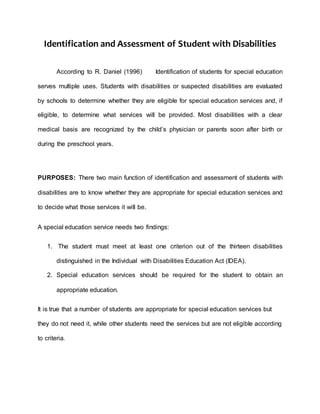
Summary of identification and assessment of student with disabilities by sheena bernal
- 1. Identification and Assessment of Student with Disabilities According to R. Daniel (1996) Identification of students for special education serves multiple uses. Students with disabilities or suspected disabilities are evaluated by schools to determine whether they are eligible for special education services and, if eligible, to determine what services will be provided. Most disabilities with a clear medical basis are recognized by the child’s physician or parents soon after birth or during the preschool years. PURPOSES: There two main function of identification and assessment of students with disabilities are to know whether they are appropriate for special education services and to decide what those services it will be. A special education service needs two findings: 1. The student must meet at least one criterion out of the thirteen disabilities distinguished in the Individual with Disabilities Education Act (IDEA). 2. Special education services should be required for the student to obtain an appropriate education. It is true that a number of students are appropriate for special education services but they do not need it, while other students need the services but are not eligible according to criteria.
- 2. Current Practices: For some reasons, students are classified by their main disability; despite the fact that it is not extraordinary for a student to have disabilities in more than one category. Categories Thirteen disabilities are briefly defined in the federal IDEA regulations: Autism, deaf-blindness, deafness, hearing impairment, mental retardation, multiple disabilities, orthopedic impairment, serious emotional disturbance, learning disability, speech or language impairment, traumatic brain injury, and visual impairment. Medical and Social Models The special education classification system engages a combination of medical and social system models of deviance. The least unclear disabilities are the obviously medical disabilities, often identified by the child’s physician quickly after birth or throughout schooling years. Also, there is a study connecting biological factors to mild disabilities such as learning disability, and in particular reading disabilities. Distribution and Severity of Disabilities: It is important to remember that (1) prevalence of disabilities differ by age and category, (2) the high-incidence disabilities such as learning disability and speech or language impairment occur primarily at mild level, and (3) even “mild” disabilities may constitute formidable barriers to attaining adult goals such as high-status career.
- 3. Diagnosis, Classification, and Treatment: Classification for learning disability typically involves teacher or parent referral because of concerns on attainment lagging behind the child’s obvious intelligence or measured IQ. The assessment naturally consists of observation in the regular classroom, analysis of the child’s educational history including past test scores, assessment with standardized tests of achievement and intellectual functioning, and eradicates other potential causes of the learning problem. Stigma The degree to which lifelong, permanent negative effects of labeling occur is disputed. Concerns about the effects of classification on individuals have led to calls for removal of the common classification categories. Relation of Classification to Treatment The information needed to find out whether or not a student is appropriate to be classified as learning disabled, mildly intellectual disability, or seriously emotional disturbed usually DOES NOT relate closely to treatment decisions regarding individual goals, objectives, observing of interventions, or evaluating product. Positive Features of the Current Classification System: The modern categorical scheme has served as: a rallying point for advocacy groups seeking support for programs,
- 4. structure for passage of legislation, and basis for allocation of monies to establish educational services for students with disabilities. Alternatives to the Current System: In general objective of the special education disability classification system should be used to improve the value of interventions and enhance outcomes for children and even youth with disabilities. Dimensional, Not Typological Classification systems should be based on dimensions of performance (reading, social conduct, and the like). Knowledge Based on Effective Intervention There is a body of information linked to the usefulness of instructional interventions. Classification systems focus on functional dimensions of performance will ease the application of knowledge base. Number of Deficits Quantity of deficits exhibited by the student serves as bases for age group. Students with important discrepancies over greater numbers of functional dimensions over larger numbers of functional dimensions usually need more special education services.
- 5. Degree of Discrepancy Bigger discrepancies typically point out greater need, requiring greater resources for valuable intervention. In one moment, this should not be applied as a reason for giving low priority to early intervention for students whose differences from the norm are not yet great. Conclusions Using of the accessible knowledge base and assessment technology is required to additional goal of improving the outcomes of educational interventions for children and youth.
- 6. Reference: The Future of Children SPECIAL EDUCATION FOR STUDENTS WITH DISABILITIES Vol. 6 * No. 1 - Spring 1996 Pages 40- 51
